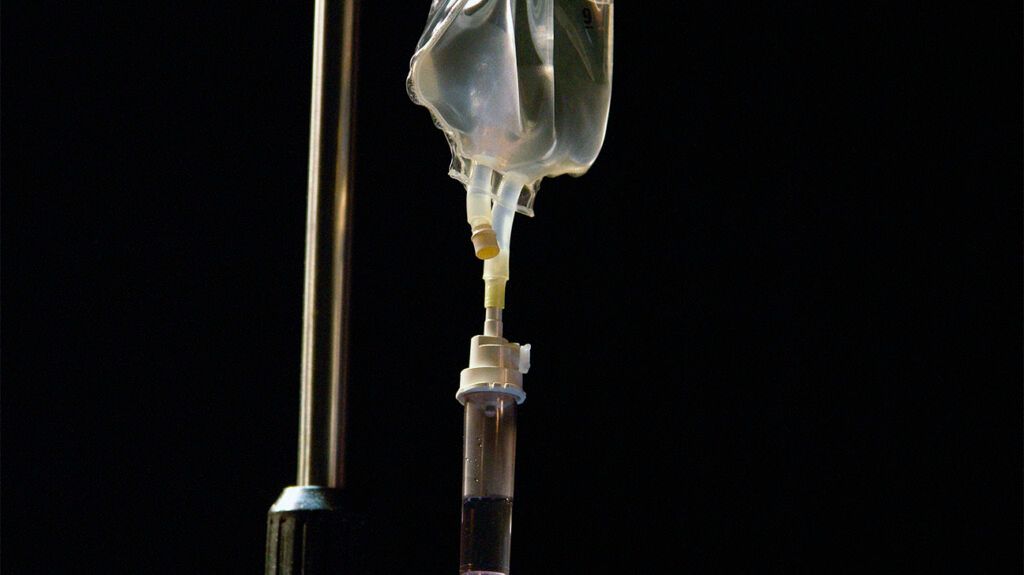Thrombolytic therapy defines a group of medications that can dissolve blood clots. Healthcare professionals may administer them to treat a medical emergency, such as a heart attack or stroke.
The blood clotting process occurs to prevent excessive bleeding when the body identifies an injured blood vessel. A blood clot typically forms over the injury to slow down and stop the bleeding. The body then dissolves the blood clot back into the bloodstream.
However, blood clots can form inside blood vessels without any apparent injury, or the body may be unable to dissolve them. These blood clots can lead to serious conditions, such as a heart attack or stroke.
This article discusses how thrombolytic therapy works, who may need it, and some examples of the different medications used. It also explores possible risks and side effects of thrombolytic therapy and a person’s potential outlook.

The natural process the body uses to dissolve blot clots involves the protein plasmin, which exists within the blood clot. Another blood protein, plasminogen, activates the plasmin which then breaks down and dissolves the clot.
Thrombolytic therapy
First, the thrombolytic therapy medication binds to the surface of the blood clot. It then activates the plasminogen within the clot surface. This then activates the plasmin within the clot, which starts to break it down until it dissolves.
There are two types of thrombolytic therapy,
- Fibrin-specific plasminogen activators: This type of thrombolytic therapy mainly activates the plasminogen bound to the surface of the clot. These medications include alteplase, reteplase, and tenecteplase.
- Nonspecific plasminogen activators: This type of thrombolytic therapy can activate both the plasminogen on the clot surface and the plasminogen circulating in the bloodstream. These medications include streptokinase and urokinase.
Thrombolytic therapy works to dissolve blot clots, restoring the normal flow of blood.
A person may require thrombolytic therapy in an emergency,
- ischemic stroke
- heart attack
- blood clot within a vein
- blood clot within the arteries that supply blood to the limbs
- blood clot in the heart
- blood clot that forms around a catheter
- blood clot within the lungs
There are several types of thrombolytic therapy medications that a doctor
The types of thrombolytic therapy medications that a doctor may prescribe administering in an emergency
- streptokinase
- urokinase
- tenecteplase
- reteplase
- alteplase
- prourokinase
The different types of thrombolytic therapy work in various ways; however, they do share many similarities.
Streptokinase
Streptokinase is the
A doctor will typically prescribe administering streptokinase through an IV line.
Urokinase
Urokinase is another type of thrombolytic therapy that can activate the plasminogen on both the surface of the blood clot and in the bloodstream.
A doctor will typically prescribe administering urokinase through an IV or intra-arterial line.
Tenecteplase
The use of tenecteplase is common in the United States, except for when a person has an ischemic stroke.
Tenecteplase is a type of thrombolytic therapy that mainly activates the plasminogen on the surface of the blood clot.
A doctor will typically prescribe administering tenecteplase through an IV line.
Reteplase
Reteplase is a type of thrombolytic therapy that mainly activates the plasminogen on the surface of the blood clot. It typically works quickly and can have a lower risk of bleeding than other thrombolytic therapy medications.
A doctor will typically prescribe administering reteplase through an IV line.
Alteplase
Alteplase is one of the most common types of thrombolytic therapy that a doctor may use to treat a mild heart attack, an ischemic stroke, and a blood clot in the lungs.
Alteplase is a type of thrombolytic therapy that mainly activates the plasminogen on the surface of the blood clot.
A doctor
Prourokinase
Prourokinase is a type of thrombolytic therapy that mainly activates the plasminogen on the surface of the blood clot. It is a new type of thrombolytic therapy that is still undergoing clinical trials.
A doctor will typically prescribe administering prourokinase through an IV line.
A 2023 study suggests that prourokinase
There are individual risks and side effects of each type of medication. However, there are several that are similar across all types of thrombolytic therapy,
- allergic reactions, which can involve anaphylaxis in rare cases
- bleeding
- low blood pressure
- sudden swelling
- irregular heartbeat
Thrombolytic therapy may not be suitable for some individuals, including those who have experienced:
- recent intracerebral hemorrhage
- ischemic stroke within the past 3 months
- head or facial injury within the past 3 months
- recent surgery of the skull or spine
- severe unmanaged high blood pressure
- aortic dissection
- brain tumor
If a person in an emergency situation receives thrombolytic therapy, a doctor will prescribe monitoring blood pressure regularly for
The recovery process and life expectancy following thrombolytic therapy may vary depending on the health condition that has caused the blood clot.
Research from 2021 suggests that if a person receives thrombolytic therapy for an ischemic stroke through an IV line, the median life expectancy is approximately
Other 2021 research suggests that a person who receives thrombolytic therapy following an ischemic stroke may live for approximately
Thrombolytic therapy involves a group of medications that can break down and dissolve a blood clot in a medical emergency, such as a heart attack or stroke.
These medications work by replicating the natural process of the body, binding to a blood clot and activating the proteins that dissolve it.
As with all medications, there are several risks and side effects of thrombolytic therapy, including bleeding, allergic reactions, and low blood pressure.
Examples of thrombolytic therapy medications include alteplase, streptokinase, and tenecteplase.
